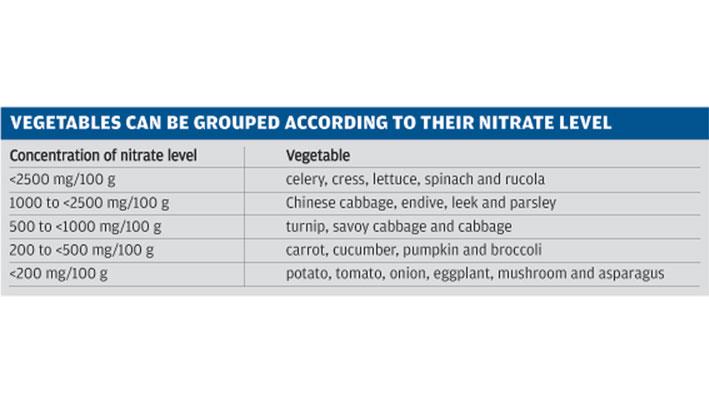Nitrates and nitrites are commonly found in food and water sources and are used as preservatives in various processed foods. While they can provide many benefits such as preventing spoilage and bacterial growth, studies have shown that excessive consumption of nitrates and nitrites can lead to several health risks. The main sources of nitrates and nitrites include fertilizers, manure, and sewage, which can contaminate the soil and water. In addition, they are present in high levels in cured meats such as bacon, ham and hot dogs. These foods have been linked to an increased risk of cancer, particularly colorectal cancer, as well as other health issues such as heart disease, diabetes and birth defects.
Nitrates (NO3-) are water soluble inorganic salts that are found in our daily diet. Its solubility makes it easily found in soil and water, nitrates are also introduced to fertilizers and preservatives; these are usually harmless. When nitrates are introduced into the oral cavity and stomach they encounter commensal bacteria in the saliva which convert nitrates into nitrites. Nitrites can be considered beneficial when converted into nitric oxide, however it can also form into nitrosamines, which can have a negative effect, cancer-causing cell effect.
As the debate over the safety of nitrates and nitrites continues, it is crucial to raise awareness about their sources and risks and to promote healthy eating habits to safeguard our health.
There has been an increase in nitrate concentration consumption in the population, which causes concern for public health. The World Health Organisation (WHO) accredits a progressively increasing nitrate intake concentration of 90% by the general population. Various studies identified that a high consumption of nitrates are considered as harmful. These are considered causative factors in oesophageal carcinoma, gastric tumours, colon cancer and other tumours. Therefore, the WHO recommends that the upper limit of daily nitrate and nitrite concentration intake to be 3.7mg/kg and 0.06-0.07mg/kg, respectively.
Food
Nitrates are widely present in soil, water, air and plants. Nitrates are highly present in our daily diet: 80%-90% from vegetables, especially green leafy vegetables, such as spinach and beetroot; 15-20% from drinking water and 10-15% from animal-based products.

Food industries utilize nitrites for food preservation, especially to prevent bacterial growth (also known as botulism). Nitrites are universally added to cured meat such as bacon, lunchmeat and hot dogs and also fertilized vegetables such as spinach, beetroot juice and arugula, and fish.
Water
Nitrates are a common contaminant in drinking water, the major source being fertilizers in agricultural activities, sewage systems and animal waste. The content of nitrates in the water is dangerous, since when boiled or inside the body this turns into nitrites, which in concentrated doses may induce methaemoglobinaemia (MGA) and thyroid disease. MGA is the increased affinity of red blood's cells to oxygen which when ingested by a bottle-fed infant may inevitably affect the oxygen-carrying capacity of the infant's blood. In concentrated doses this may induce shortness of breath leading to cyanosis that is blue-coloured skin. The WHO recommends that the nitrate concentration levels in drinking water is to be 50 mg/L
Function of nitrates and nitrites
It has been noted that nitrates have numerous beneficial functions when consumed within the limits recommended by the WHO. Nitrates have the ability to prevent bacterial growth (also known as Clostridium botulinum) therefore increasing food preservation. It is utilized by food industries to give food a more eye-catching colour and retard food odours.
Nitrates when successfully converted to nitric oxide, have numerous beneficial functions in our bodies, some of which consists of:
- the inhibition of platelet aggregation, protection to our vascular system and reduction of the blood pressure,
- prevents ischemic heart disease,
- improve age-related high blood pressure, and
- suppress inflammatory process and provides a compensatory mechanism when our body is under stress (such as hypoxia or ischaemia)
A study was carried out consisting of 22 mice having nitrate and nitrite deficiency - this resulted in deaths within 22 months because of cardiovascular, endothelial dysfunction and metabolic syndrome.
Conclusion
It is safe to say that our bodies need a balanced amount of dietary nitrates; since this provides a positive physiological activity together with numerous protective factors, some of which include disorders such as heart attacks, stroke, lung disorders and gastric ulcers. When consumed within the recommended levels, nitrate benefits outweigh the risks. Despite controversial claims, there is no confirmed evidence associating dietary nitrate with cancer. Current research targeting nitrite and tumours overlooked the complex components in target foods, thus resulting in the existent contradictions between researchers. Some guidelines, which would result in the improvement of economic health, include testing of meat product's concentration of nitrates, decrease the consumption of fertilizers and purification, testing and filtration of drinking water so as to filter high concentrations of nitrates, which are water soluble. Various other guidelines to reduce the risk of disease was recommended by the American Cancer Society, which stated that people should increase the consumption of vegetables, fruits and whole grains and limit processed meats.
Renald Blundell is a biochemist and biotechnologist with a special interest in Natural and Alternative Medicine. He is a professor at the Faculty of Medicine and Surgery, University of Malta
Eleanore Cricchiola worked as a staff nurse in 2013; graduated in Bachelors of Science (Honours) Health Science in 2016. Proceeded to graduate as a Doctor of Medicine and Surgery in 2021